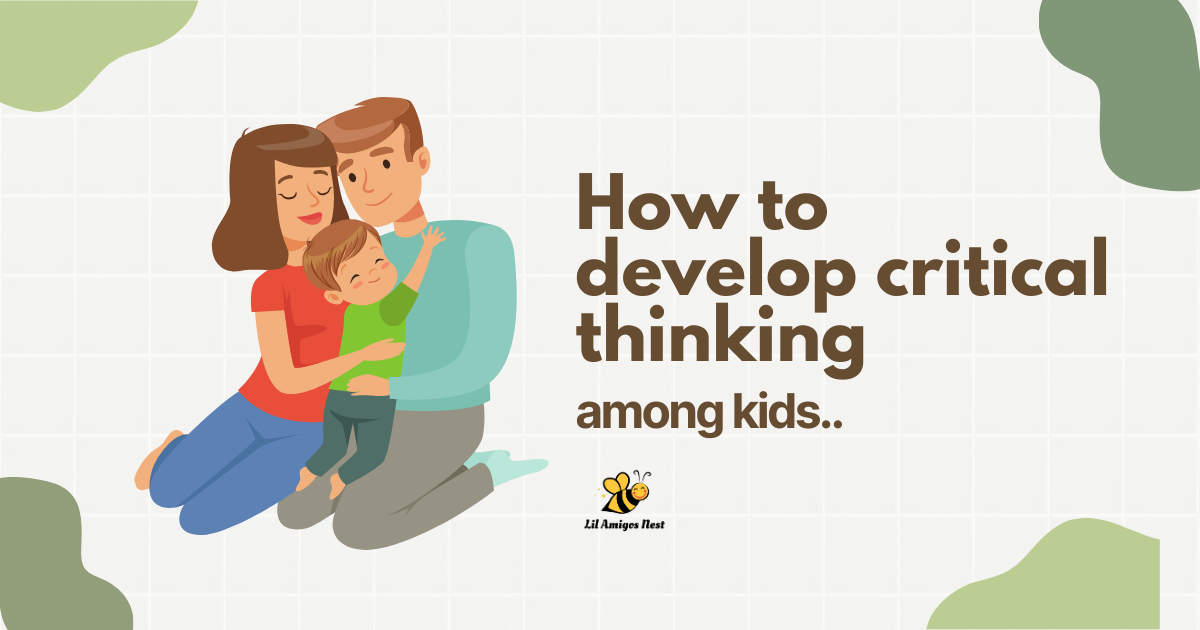How to Develop Critical Thinking in Kids

Every parent wants their child to grow up confident, smart, and capable of making good decisions. But beyond memorizing facts or scoring well in school, there’s a deeper skill that truly shapes kids' growth, critical thinking. It helps children analyze situations, ask the right questions, and make thoughtful choices. In today’s world, where kids are surrounded by endless information, developing this skill early can make all the difference.
As a parent, you don’t need to be a psychologist or teacher to build this ability in your child. What you do need are the right parenting tips, a bit of patience, and daily opportunities that encourage curiosity and reflection. Whether you’re following advice from a parent portal, reading a parenting guide, or simply learning as you go, nurturing critical thinking can become a natural part of your child’s development and growth.
Why Critical Thinking Matters in Kids' Development
Critical thinking isn’t just about being “smart.” It’s about understanding why something happens, not just what happens. When kids think critically, they learn how to:
- Ask meaningful questions
- Understand cause and effect
- Make decisions after considering different sides
- Solve problems without relying solely on adults
- Handle failure and learn from mistakes
This skill builds a strong foundation for lifelong learning. A child who can think critically won’t just memorize facts for a test; they’ll know how to apply knowledge in real life. That’s the kind of thinking every parent hopes to inspire.
Start with Curiosity: Encourage Questions
Every child starts with curiosity. You’ve probably heard your little one ask a hundred “why” questions in a day. That’s a good thing! Instead of brushing them off, treat those questions as openings to build reasoning skills.
For example:
When your child asks, “Why is the sky blue?” instead of saying, “That’s just how it is,” you can reply, “That’s a great question. What do you think makes it blue?”
This small shift turns a one-way answer into a two-way conversation. Asking critical thinking questions like “What do you think?” or “Why do you believe that?” helps children process ideas and form their own opinions.
Make Thinking Visible
Kids learn best when they can see how thinking works. Talk out loud when you make decisions. For instance, say:
“I’m choosing this route because there’s less traffic today,” or
“I’m using this recipe because it’s healthier.”
This helps children understand that choices come from reasoning, not chance. When you model your thought process, they start copying it, a simple yet powerful way to build critical thinking habits.
Encourage Problem-Solving through Daily Activities
Critical thinking grows through practice, not lectures. Use daily situations to engage your child’s mind.
Here are a few examples:
- Cooking together: Ask them to measure ingredients and guess what happens if they add too much salt.
- Shopping: Let them compare two similar products and decide which one is better and why.
- Board games or puzzles: Encourage strategy, patience, and reflection after each round.
Everyday tasks become meaningful lessons when you let your child take part in the decision-making.
Let Them Make Mistakes: and Learn from Them
One of the biggest mistakes parents make is protecting kids from failure. It’s natural to want your child to succeed, but overprotection can limit their learning.
When your child makes an error, say, forgetting their homework or spilling a drink, avoid jumping in to fix it immediately. Instead, help them think about what went wrong and how they can prevent it next time.
Ask questions like:
- “What could you do differently next time?”
- “Why do you think this happened?”
This builds self-reflection and problem-solving, both essential parts of kids' development.
Promote Reading and Storytelling
Books are one of the best tools for developing critical thinking. Reading opens doors to new perspectives, challenges, and emotions. After reading a story, discuss it together.
Ask your child:
- “Why do you think the character made that choice?”
- “What would you have done differently?”
- “What lesson can we learn from this story?”
This kind of discussion encourages empathy, analysis, and reasoning, all key parts of critical thinking. You can also encourage storytelling. When your child creates their own story, they learn how to organize thoughts, solve problems in the plot, and think creatively.
Limit Passive Screen Time
Screens are everywhere: TVs, tablets, phones. While educational videos can be useful, too much passive screen time reduces opportunities for thinking and creativity.
Encourage interactive content instead. Choose games or apps that challenge logic, memory, and problem-solving. Many parent portals now offer curated digital resources that balance fun with learning.
The goal isn’t to ban screens but to make them tools for active learning, not passive watching.
Encourage Discussions, Not Arguments
Kids often have strong opinions. Instead of shutting them down, use discussions to teach reasoning. If your child disagrees with you, that’s okay; it means they’re thinking.
For example:
If they say, “I don’t think bedtime should be this early,” instead of saying, “Because I said so,” try, “I understand you feel that way. Tell me why you think that, and let’s see what makes sense.”
When children feel heard, they learn how to present their opinions respectfully and listen to others — a key social aspect of critical thinking.
Use Open-Ended Questions
Closed questions (like “Did you finish your homework?”) only lead to yes or no answers. Open-ended questions make kids think deeper.
Try questions like:
- “What part of your homework was most interesting?”
- “How did you decide what to draw?”
- “What was your favorite thing about today, and why?”
These encourage conversation, reflection, and emotional expression.
Play Strategy-Based Games
Games like chess, Sudoku, or even simple card games sharpen logic and reasoning. They also teach patience and planning, qualities essential for critical thinking.
You don’t need fancy toys. Even old-school games like tic-tac-toe or “20 Questions” can do the job. The idea is to make thinking fun.
Expose Them to Real-Life Experiences
Critical thinking isn’t limited to books or games. It grows from real-world exposure. Take your kids to museums, farms, or community events. Let them see how things work.
After each outing, talk about what they learned. For example:
- “What surprised you the most today?”
- “How do you think people in this job solve problems?”
This helps kids connect learning with real-life applications.
Teach Them to Identify Facts vs. Opinions
In the age of social media and quick information, teaching kids how to distinguish facts from opinions is vital.
Try this exercise:
When watching the news or reading an article, pause and ask, “Is this a fact, or is it someone’s opinion?”
This habit encourages critical consumption of information and helps prevent blind acceptance of everything they hear or see.
Reward Effort, Not Just Results
When you praise only high grades or achievements, kids may start fearing mistakes. Instead, focus on effort and curiosity.
Say things like:
- “I love how you tried different ways to solve that problem.”
- “You worked hard to understand it, that’s great thinking.”
This builds confidence and a love for learning, which fuels long-term critical thinking skills.
Be Patient and Consistent
Developing critical thinking isn’t a one-week project. It’s a continuous journey. Some days your child may seem uninterested or distracted; that’s normal. The key is consistency.
Keep conversations open. Keep asking questions. Keep letting them think. Over time, these small efforts shape independent, thoughtful minds.
Use the Parent Portal or Parenting Guide for Support
Today, many schools and educational platforms offer online parent portals filled with resources, activities, and progress insights. Use these tools to track your child’s growth and get practical parenting tips.
You can also refer to credible parenting guides that focus on building emotional intelligence and cognitive skills. They often include fun exercises to boost critical thinking at home. The idea is to blend traditional parenting with modern tools for a balanced approach.


























